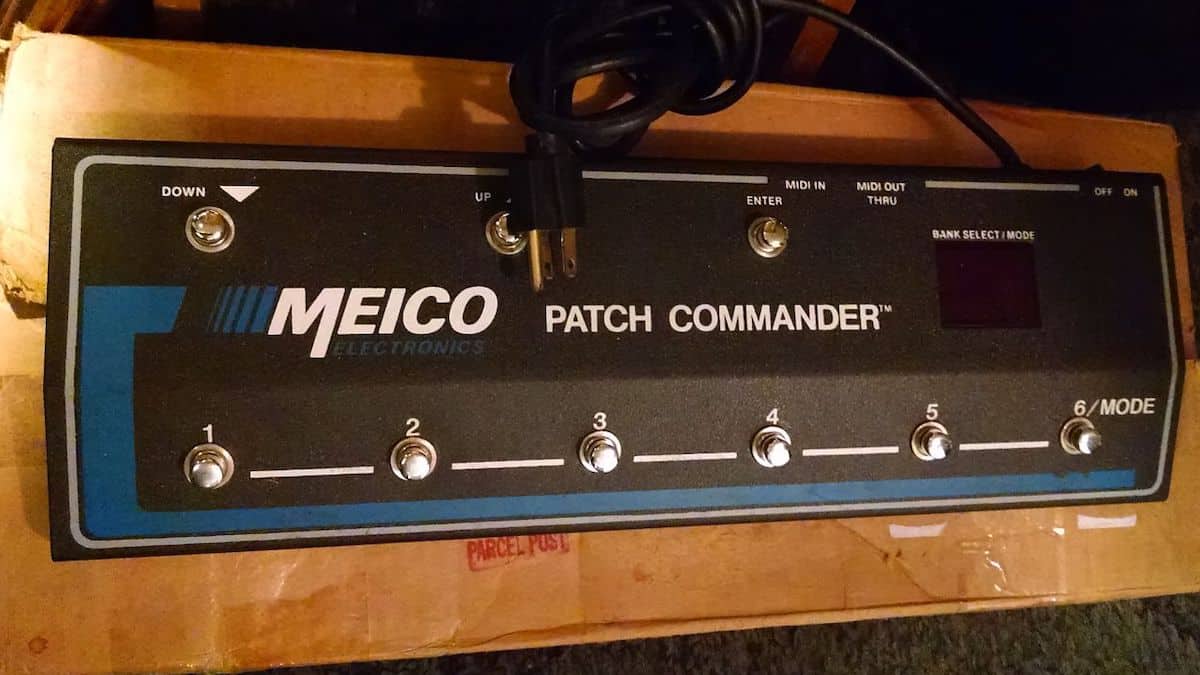Columns
Curio Cabinet: Meico Electronics Patch Commander & MIDI Commander (c.1987)

In this Synth and Software series, Malcolm Doak takes a look back at interesting MIDI products from the past. Next up, Meico Electronics Patch and MIDI Commander.
One of the most enduring aspects of MIDI is that, by and large, it is a pretty simple code. This means that anyone so inclined can make some cool MIDI gadgets. And for decades, many have. One such company was


Both the Meico Patch Commander and the Meico MIDI Commander are programmable MIDI foot pedal controllers.
The sturdy metal construction is peppered with a number of industrial-grade metal footswitches. The internal power supply means that each unit has an attached cable that plugs directly into the wall. On the back are the MIDI jacks. An internal battery keeps the memory intact when the unit is unplugged or in transit. The Patch Commander offers a simple 2-digit LCD display; the MIDI Commander needs no display. Though nearly identical in size (17” x 5.5”), shape, and construction, each of these products satisfies a unique MIDI need.
This product appeared in the mid-to-late 1980s – the heyday of the giant MIDI hardware rig, and the pre-DAW era.
Let’s explore the
Once in the Program Mode, programming the Meico Patch Commander is straightforward, but tedious. As with the Yamaha MCS2 discussed in a previous column, a handy hexadecimal table for entering Program Change commands is included. Hexadecimal data was popular in the 1980s, as it generally only required a two-digit display to display values up to 128 (7F) and beyond. The MIDI channel number and MIDI Program Change number can be entered using the buttons on the Patch Commander. This same information can also be quickly entered via MIDI, using a connected MIDI instrument or controller keyboard.

For me, the far more interesting and appealing product is the Meico MIDI Commander.
Think of it is a sampler, but for MIDI data – not audio. Each of the footswitch buttons on the pedalboard can memorize a packet of incoming MIDI data, to be recalled and played back later. This can be a Program Change command, a single bass note drone, a chord, or even something like a MIDI Start command for a sequencer or drum machine. Unfortunately, it will not record the continuous change in
I’ve been spending much of my quarantine “down-time” streamlining the live rig for one of my projects, an 80s dance hit cover band.
Consolidating everything into a single keyboard has set me musing over the features I rely on when performing this material. Although this band uses no sequencers or computers live, I still enjoy using a little “sleight-of-hand” as we play live, changing sounds and adding effects effortlessly and without any tell-tale visuals. So as I consider integrating the 12 Step from Keith McMillen Instruments, and explore the value – and novelty – of the Chord Trigger buttons of my Korg M3-73, I am transported to another time and place, and remembering the contributions of
In fact, the Chord Trigger buttons on my Korg M3-73 (which originated on the OASYS) are very similar in use to the footswitches of the Meico MIDI Commander. I use these buttons not because I can’t play chords. I use them to fire off internal samples (Peter Gabriel’s “Hi There”). These pads can trigger a pattern (the harp gliss on “Let’s Go Crazy” or the giggle-stick arpeggiator on “Hungry Like the Wolf). Add to that the more musical uses of droning a bass note (the middle eight of “Rebel Yell”) or playing lush layers of string and vocal pads as I play piano live over them from the keyboard (“Purple Rain”). And unlike the Chord Trigger buttons, the Meico MIDI Commander would let me do all that without taking my hands from the keyboard. Pretty cool. Looking to expand on what can be done from a foot pedal controller has me considering the impressive 12 Step from Keith McMillen Instruments. Although not limited to MIDI Program Change commands, the 12 Step does share an evolutionary branch with the Meico Patch Commander.
Shout out to my friend and former Meico Sales Rep Dave Spaulding for jogging my Meico memories.
A review of the
For More Curio Cabinet Articles















